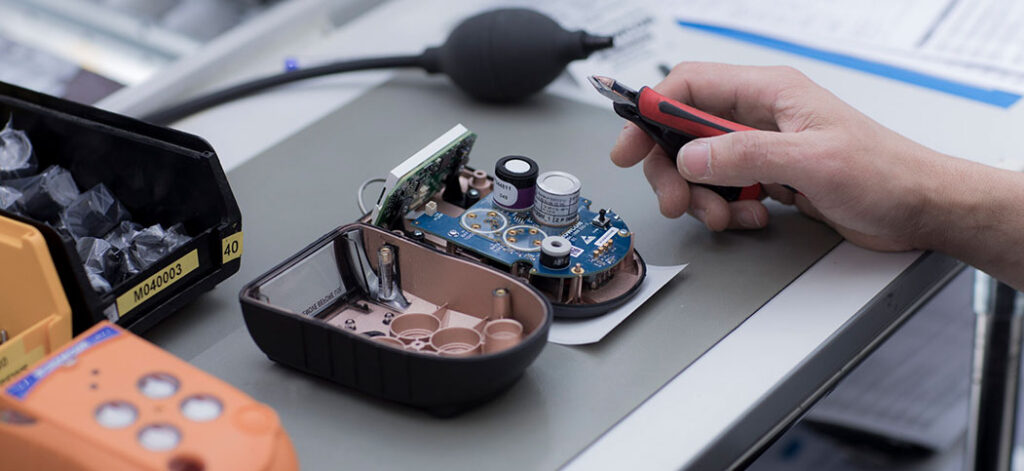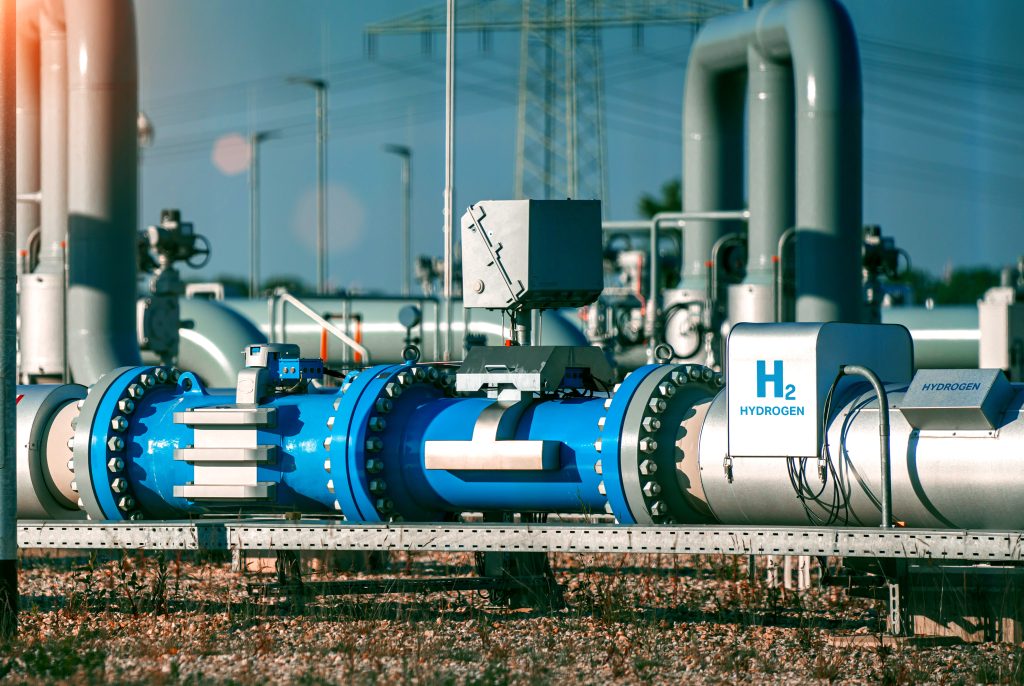Die Entwicklung der Gasüberwachung hat sich im Laufe der Jahre stark verändert. Neue, innovative Ideen von Kanarienvögeln bis hin zu tragbaren Überwachungsgeräten bieten den Arbeitern eine kontinuierliche, präzise Gasüberwachung. Gaswarngeräte lassen sich in die Überwachung von Gas mit Hilfe von Sensoren und Gaspfadtechnologie, die Benutzerschnittstelle, die Menschen oder Geräte über notwendige Maßnahmen informiert, und das unterstützende Energiemanagementsystem, das alles auflädt und am Laufen hält, unterteilen. Zu diesem Paket können wir nun einen vierten Aspekt hinzufügen - die Kommunikations- und Aufzeichnungstechnologie.
Arten von Sensoren
Photo-Ionisations-Detektion (PID)
Die PID-Technologie gilt allgemein als die Technologie der Wahl für die Überwachung der Exposition gegenüber toxischen VOC-Werten. Die Sensoren enthalten eine Lampe als Quelle für hochenergetisches ultraviolettes (UV) Licht. Die Energie des UV-Lichts regt die neutral geladenen VOC-Moleküle (flüchtige organische Verbindungen) an, indem sie ihnen ein Elektron entzieht, so dass sie geladen sind. Dann fließt ein Strom zwischen zwei geladenen Platten im Sensor, und die Gaskonzentration ist proportional zu diesem Strom.
Elektrochemisch
Elektrochemische Sensoren messen Gas, das durch ein kleines Loch in der Stirnseite der Zelle eintritt, durch einen PTFE-Feuchtigkeits- und Ölfilter und über eine elektrochemische Lösung auf eine Elektrode gelangt. Sensorreichweiten und Empfindlichkeiten können durch die Verwendung unterschiedlich großer Löcher variiert werden, wobei größere Löcher eine höhere Empfindlichkeit und Auflösung und kleinere Löcher eine geringere Empfindlichkeit und Auflösung, aber eine größere Reichweite bieten. Die gemessene Gasart wird durch die Wahl des Elektrodenmaterials, die Wahl des Elektrolyten und manchmal auch durch die Verwendung von Filtern zum Blockieren unerwünschter Gasarten bestimmt.
Katalytische Perlen (Pellistor)
Pellistor-Sensoren bestehen aus zwei aufeinander abgestimmten Drahtspulen, die jeweils von Keramikkugeln umschlossen sind. Durch die Widerstandsspulen wird Strom geleitet, der sie auf etwa 230 °C erhitzt. Eine der Perlen enthält ein Katalysatormaterial. Wenn also ein Gemisch aus Luft und brennbarem Gas in den Sensor eintritt, kommt es mit den Perlen in Kontakt und verbrennt in der Nähe derjenigen, die den Katalysator enthält. Dies führt zu einem Temperaturunterschied zwischen dieser aktiven und der anderen "Referenz"-Perle. Die Temperaturdifferenz verursacht einen Widerstandsunterschied, der gemessen wird; die Menge des vorhandenen Gases ist direkt proportional zur Widerstandsänderung, so dass die Gaskonzentration in Prozent der unteren Explosionsgrenze (% UEG*) genau bestimmt werden kann. Pellistor-Sensoren sind in der Industrie weit verbreitet, z. B. auf Ölplattformen, in Raffinerien und in unterirdischen Bauumgebungen wie Bergwerken und Tunneln.
Infrarot-Sensoren
Die Infrarotstrahler im Sensor erzeugen jeweils einen IR-Lichtstrahl. Jeder Strahl durchläuft eine Probe der Atmosphäre und wird von einem Photoempfänger gemessen. Ein "Messstrahl" mit einer Frequenz von etwa 3,3 μm wird von Kohlenwasserstoffgasmolekülen absorbiert, so dass die Strahlintensität verringert wird, wenn eine entsprechende Konzentration eines Gases mit C-H-Bindungen vorhanden ist. Ein "Referenzstrahl" (in der Regel mit einer Frequenz von etwa 3,0 μm) wird nicht von Gasmolekülen absorbiert, so dass er den Empfänger mit voller Stärke erreicht. Der %LEL des vorhandenen Gases wird durch das Verhältnis der vom Photoempfänger gemessenen Strahlen bestimmt.
Molekulares Eigenschaftsspektrometer™ (MPS™)
MPS™ Sensoren stellen die neue Generation von Detektoren für brennbare Gase dar. MPS™ kann viele Gasarten schnell erkennen und über 15 charakterisierte brennbare Gase auf einmal identifizieren. Bis vor kurzem musste jeder, der brennbare Gase überwachen wollte, entweder einen herkömmlichen Detektor für brennbare Gase wählen, der einen für ein bestimmtes Gas kalibrierten Pellistor-Sensor enthielt, oder einen Infrarotsensor (IR), dessen Leistung ebenfalls je nach dem gemessenen brennbaren Gas variiert und der daher für jedes Gas kalibriert werden muss. Auch wenn diese Lösungen vorteilhaft sind, so gibt es doch Umgebungen, in denen sie eingesetzt werden können, und Umgebungen, die zu vermeiden sind. So müssen zum Beispiel sowohl Pellistoren als auch Infrarotsensoren regelmäßig kalibriert werden, und die katalytischen Pellistorsensoren müssen auch häufig getestet werden, um sicherzustellen, dass sie nicht durch Verunreinigungen, die permanente Gifte enthalten (so genannte "Sensorvergiftungen"), oder durch raue Bedingungen beschädigt worden sind. In manchen Umgebungen müssen die Sensoren häufig ausgetauscht werden, was sowohl in Bezug auf die Kosten als auch auf die Ausfallzeiten und die Produktverfügbarkeit kostspielig ist. Die IR-Technologie kann Wasserstoff nicht erkennen, da dieser keine IR-Signatur hat, und sowohl IR- als auch Pellistor-Detektoren erkennen manchmal zufällig andere (d. h. nicht kalibrierte) Gase, was zu ungenauen Messwerten führt, die falsche Alarme auslösen oder die Bediener beunruhigen können. Die Lösung ist der MPS-Sensor, der sowohl Wasserstoff als auch andere brennbare Gase erkennt, sie identifiziert und die richtige Kalibrierung für jedes Gas oder Gasgemisch anwendet, das er überwacht.
Einige Geräte verwenden eine Pumpe, um dem Sensor Luft- oder Gasproben zuzuführen.
Arten der Erkennung
Festgelegt
Fest installierte Gasdetektoren sind dauerhafte Vorrichtungen, die an einem Ort montiert bleiben. Sie können in Konfigurationen mit einem Detektor, in kleinen und großen Konfigurationen mit mehreren Detektoren und in einer adressierbaren "Daisy-Chain"-Schleife installiert werden. Fest installierte Gasdetektoren werden im Allgemeinen überall dort angebracht, wo eine Gefahr für Anlagen, Gebäude oder Installationen besteht, und können langsame Ansammlungen oder größere Lecks aufspüren, um eine frühzeitige oder automatische Warnung vor Gasaustritt aus einer bestimmten Quelle zu geben. Sie sind oft so eingerichtet, dass sie andere Sicherheitsmaßnahmen auslösen, d. h. sie können Entlüftungsöffnungen öffnen, Ventilatoren einschalten, Ventile schließen oder sogar Prozesse automatisch abschalten, sobald sie ein Problem erkennen. Häufig werden sie so eingerichtet, dass sie einen Kontrollraum oder das Sicherheitspersonal vor einem potenziell gefährlichen Gasaustritt warnen, so dass die entsprechenden Personen Maßnahmen ergreifen können. Sie können auch Alarme auslösen, um eine Evakuierung einzuleiten. Andererseits sind ortsfeste Gasdetektoren in der Regel nicht so konzipiert, dass sie verhindern, dass ein Arbeiter mit dem Gas in Berührung kommt, auch wenn einige Systeme eine Komponente zur Flächendeckung in ihrem Design haben. Tragbare Gasdetektoren sind der beste Weg, um Personen zu schützen, die mit giftigen oder brennbaren Gasen in Berührung kommen können, die sich bilden oder freigesetzt werden.
Jedes ortsfeste Gaswarngerät muss mit einer Zentrale kommunizieren. Die Zentrale ist das Herzstück des ortsfesten Gaswarnsystems, das die Gasmengen mit den voreingestellten Werten vergleicht und verschiedene Optionen für Eingangs- und Ausgangsfunktionen bietet. Die Gas-Bedienfelder befinden sich normalerweise in einem sicheren Bereich, können aber bei entsprechender Unterbringung auch in Gefahrenzonen installiert werden. Sie kommunizieren mit Gaswarnsensoren oder -transmittern und können mit einem zentralen Punkt vernetzt werden, so dass mehrere Bedientafeln/Systeme aus der Ferne überwacht werden können. Für die Kommunikation mit fest installierten Gasdetektoren gibt es mehrere Methoden. Die gebräuchlichste ist die analoge, aber es gibt auch eine wachsende Nachfrage nach digitaler und drahtloser Kommunikation. Es gibt auch verschiedene Funktionen, die über den Detektor verfügbar sind, um die Effizienz zu verbessern und die Zeit zu reduzieren, die das Personal an potenziell gefährlichen Orten verbringt, wodurch das Risiko für Menschen verringert wird.
Tragbar
Tragbare Gasdetektoren sind persönliche Schutzgeräte, die den Atembereich des Benutzers kontinuierlich überwachen. Da sie in der Regel klein sind, werden diese handgehaltenen, leichten und robusten Geräte am Körper getragen und sind so konstruiert, dass sie ergonomisch sind und unauffällig getragen werden können. Manchmal werden sie auch eingesetzt, um enge Räume wie Tanks zu überprüfen, in denen die Art des Gasrisikos bekannt ist, bevor jemand den Raum betritt. Sie sind für die Überwachung aus nächster Nähe gedacht und eignen sich in der Regel nicht für die langfristige Dauerüberwachung größerer Räume. Tragbare Gasdetektoren sind die sicherste und bewährteste Methode, um einzelne Arbeitnehmer zu schützen, während sie sich fortbewegen.
Tragbare Detektoren speichern Informationen über die Gasbelastung während einer Schicht sowie Ereignisse wie Alarme oder Beinaheunfälle. Diese Daten können an ein cloudbasiertes Portal übertragen werden, um zahlreiche Vorteile wie verbesserte betriebliche Effizienz und Sicherheitskonformität zu ermöglichen und einen robusten und flexiblen Mechanismus zu bieten, der wertvolle, umsetzbare Erkenntnisse liefert. Datenlösungen bieten greifbare Vorteile für tragbare Flotten aller Größen, unabhängig davon, ob die Gaswarngeräte vor Ort, außerhalb des Betriebs oder in beiden Fällen eingesetzt werden. Tragbare Gaswarngeräte kosten in der Regel weniger als stationäre Systeme und sind meist batteriebetrieben. Andererseits muss jeder Benutzer für die Bedienung seines tragbaren Gaswarngeräts entsprechend geschult werden. Außerdem sind tragbare Detektoren in der Regel nicht direkt mit anderen Sicherheitssystemen verbunden. Wenn der Melder einen Alarm auslöst, muss der Benutzer daher selbst Maßnahmen ergreifen, um das Risiko für sich und andere zu verringern.
BRANCHENEINBLICKE
Melden Sie sich an, um die neuesten Erkenntnisse zu erhalten
IN Ihrem Posteingang
Lesen Sie über Crowcon's Datenschutz und Cookie-Richtlinie hier. Wenn Sie Ihre Meinung ändern, können Sie sich jederzeit abmelden






